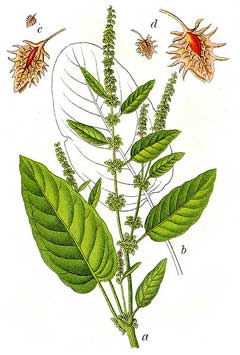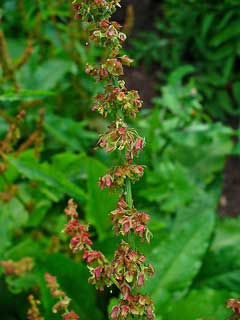 |
|
http://commons.wikimedia.org/wiki/File:Rumex_obtusifolius_Sturm48.jpg |
 |
| http://commons.wikimedia.org/wiki/User:Llez |
Translate this page:
Summary
Physical Characteristics

 Rumex obtusifolius is a PERENNIAL growing to 1 m (3ft 3in).
Rumex obtusifolius is a PERENNIAL growing to 1 m (3ft 3in).
See above for USDA hardiness. It is hardy to UK zone 5. It is in flower from June to October, and the seeds ripen from July to October. The species is hermaphrodite (has both male and female organs) and is pollinated by Wind.
It is noted for attracting wildlife.
Suitable for: light (sandy), medium (loamy) and heavy (clay) soils and prefers well-drained soil. Suitable pH: mildly acid, neutral and basic (mildly alkaline) soils and can grow in very acid and very alkaline soils.
It can grow in semi-shade (light woodland) or no shade. It prefers moist soil.
UK Hardiness Map
US Hardiness Map
Synonyms
Acetosa oblongifolia (L.) A. Löve & D. Löve. Rumex obtusifolius L. ssp. sylvestris
Plant Habitats
Woodland Garden Dappled Shade; Shady Edge; Meadow; Hedgerow;
Edible Uses
Edible Parts: Leaves Seed Stem
Edible Uses:
Young leaves - cooked[8, 22, 46, 61]. A bitter taste, especially if the older leaves are used[105, 183]. The leaves are usually cooked in at least one change of water in order to reduce the bitterness[183]. Leaves can also be dried for later use[12]. The leaves have a much milder flavour when they are first produced in early spring[K]. Young stems - cooked[257]. Seed - raw or cooked[102, 172]. The seed can also be ground into a powder and used to make a gruel or added to cereal flours when making bread etc[102]. It is rather small and fiddly to harvest.
References More on Edible Uses
Medicinal Uses
Plants For A Future can not take any responsibility for any adverse effects from the use of plants. Always seek advice from a professional before using a plant medicinally.
Astringent Blood purifier Contraceptive Salve
The leaves are often applied externally as a rustic remedy in the treatment of blisters, burns and scalds[4, 14]. The root contains tannin and is astringent and blood purifier[257]. A tea made from the roots has been used in the treatment of jaundice, whooping cough, boils and bleeding[4, 257]. An infusion of the root has been used as a wash, especially for children, to treat skin eruptions[257]. One report says that the root has been used as a contraceptive to stop menstruation[257]. The root is harvested in early spring and dried for later use[4].
References More on Medicinal Uses
The Bookshop: Edible Plant Books
Our Latest books on Perennial Plants For Food Forests and Permaculture Gardens in paperback or digital formats.

Edible Tropical Plants
Food Forest Plants for Hotter Conditions: 250+ Plants For Tropical Food Forests & Permaculture Gardens.
More

Edible Temperate Plants
Plants for Your Food Forest: 500 Plants for Temperate Food Forests & Permaculture Gardens.
More

More Books
PFAF have eight books available in paperback and digital formats. Browse the shop for more information.
Shop Now
Other Uses
References More on Other Uses
Cultivation details
Requires a good soil[4]. Plants are occasionally cultivated for their edible leaves[61]. A very important food plant for the caterpillars of many species of butterfly[30]. This species is an alternative host of the turnip fly[4].
References Carbon Farming Information and Carbon Sequestration Information
Temperature Converter
Type a value in the Celsius field to convert the value to Fahrenheit:
Fahrenheit:
The PFAF Bookshop
Plants For A Future have a number of books available in paperback and digital form. Book titles include Edible Plants, Edible Perennials, Edible Trees,Edible Shrubs, Woodland Gardening, and Temperate Food Forest Plants. Our new book is Food Forest Plants For Hotter Conditions (Tropical and Sub-Tropical).
Shop Now
Plant Propagation
Seed - sow spring in situ. Division in spring.
Other Names
If available other names are mentioned here
Native Range
TEMPERATE ASIA: Iran (north), Turkey (north), Azerbaijan, Georgia, China (Anhui Sheng, Zhejiang Sheng, Hebei Sheng, Hunan Sheng, Hubei Sheng, Gansu Sheng, Jiangxi Sheng, Jiangsu Sheng, Shandong Sheng, Shaanxi Sheng, Sichuan Sheng), Japan, Taiwan EUROPE: Denmark, United Kingdom, Ireland, Norway, Sweden (south), Austria, Belgium, Switzerland, Czech Republic, Germany, Hungary, Netherlands, Poland, Slovakia, Russian Federation (European part), Belarus, Estonia, Lithuania, Latvia, Moldova, Ukraine (incl. Krym), Albania, Bulgaria, Bosnia and Herzegovina, Greece, Croatia, Italy (incl. Sardinia), North Macedonia, Montenegro, Romania, Serbia, Slovenia, Spain, France (incl. Corsica), Portugal AFRICA: Algeria (north)
Weed Potential
Right plant wrong place. We are currently updating this section.
Please note that a plant may be invasive in one area but may not in your area so it's worth checking.
Conservation Status
IUCN Red List of Threatened Plants Status :

Growth: S = slow M = medium F = fast. Soil: L = light (sandy) M = medium H = heavy (clay). pH: A = acid N = neutral B = basic (alkaline). Shade: F = full shade S = semi-shade N = no shade. Moisture: D = dry M = Moist We = wet Wa = water.
Now available:
Food Forest Plants for Mediterranean Conditions
350+ Perennial Plants For Mediterranean and Drier Food Forests and Permaculture Gardens.
[Paperback and eBook]
This is the third in Plants For A Future's series of plant guides for food forests tailored to
specific climate zones. Following volumes on temperate and tropical ecosystems, this book focuses
on species suited to Mediterranean conditions—regions with hot, dry summers and cool, wet winters,
often facing the added challenge of climate change.
Read More
Expert comment
Author
L.
Botanical References
17
Links / References
For a list of references used on this page please go here
Readers comment
| Add a comment |
|
If you have important information about this plant that may help other users please add a comment or link below. Only comments or links that are felt to be directly relevant to a plant will be included. If you think a comment/link or information contained on this page is inaccurate or misleading we would welcome your feedback at [email protected]. If you have questions about a plant please use the Forum on this website as we do not have the resources to answer questions ourselves.
* Please note: the comments by website users are not necessarily those held by PFAF and may give misleading or inaccurate information.
To leave a comment please Register or login here All comments need to be approved so will not appear immediately.
|
Subject : Rumex obtusifolius
|
|
|
|